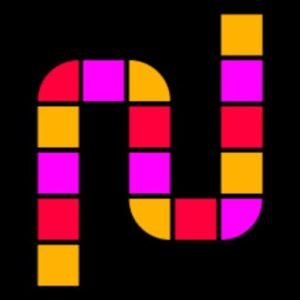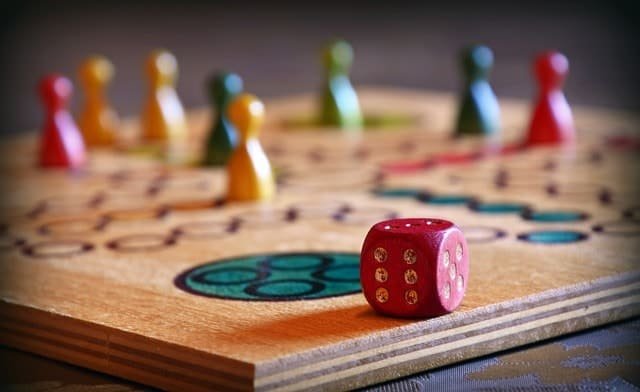
This is part of our series on the best board games by age. For more recommendations check out the comprehensive guide.
At the age of 11, children are becoming more mature and independent, finding their own feet a little more and beginning to care more about their place in the world. How they’re seen by their peers begins to become a concern for them, as they begin to figure out who they want to spend time with and how they want to spend it. Board games for 11 year olds can therefore offer a huge opportunity, not least to allow families to continue to connect regardless of individual independence, but also in giving kids the chance to share that same joy with their friends.
Board games for pre-teens should veer towards the lighter side of games, those without huge play times or novel-like rulebooks. Video games are particularly popular with this age because of how quickly they can be learned and played with others, as well as the visual stimulation, and board games are no different in this respect. Light, fun, quick and engaging traditional board games are bound to remain popular, ensuring a perfect family game night every time.
We’ve compiled a list of 8 games that make for a great addition to any gaming evening – that are perfect family board games for 11 year olds.
If you’re wondering about children of other ages, remember we have a whole section dedicated to kids gaming, so be sure to check those out.
Taco Cat Goat Cheese Pizza
By: Dolphin Hat Games
Players: 2-8
Time: 10-30 minutes
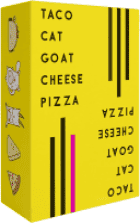
Don’t forget the order in Taco Cat Goat Cheese Pizza!
The Taco Cat Goat Cheese Pizza card game made the rounds on the internet after going somewhat viral on TikTok, and is a quick card game that’s a little like Snap. Instead of matching cards though, it’s matching words to overturned cards, with a bunch of cute illustrations to brighten up the gaming table.
Its viral fame proves it’s easy to explain the rules of it in 30 seconds. Put simply, players have a hand of cards they don’t see, and will go from player to player saying the next word in the sequence (“Taco”, then “Cat”, then “Goat” and so on), as they place an unseen card from their hand into the center deck face up. If the word spoken matches the card played down, everyone must put their hand on the pile. The last player to do so has to take the entire pile and add it to their hand. To win, you must be the first person to run out of cards. While there are a few extra rules – don’t flinch or get it wrong, or the pile is yours! – and a few extra cards that need you to take some actions, that’s essentially all you might need to know about the game.
What makes Taco Cat Goat Cheese Pizza such a perfect, interactive game for 11 year olds to play isn’t just the speed that it can be brought to the table, but the speed the rounds occur at. There’s no down time in Taco Cat Goat Cheese Pizza that might cause your 11 year old to get bored and lose interest, because even when it’s not your turn to say the word and turn over a card, you need to always be watching to see if someone else’s card matches.
The game became so popular that a number of other versions were released with different variations. If you have a younger child, the Taco Kitten Pizza version (which was nominated for a prestigious award) requires less to remember, and less race-to-the-deck movement, that makes it suitable for as young as 4 – though we have our own recommendations for games for 4 year olds. For this age though, Taco Cat Goat Cheese Pizza has it all.
We earn a commission if you make a
purchase, at no additional cost to you.
For even more card games, check out our list of the card games like Uno.
Hues and Cues
By: The Op Games
Players: 3-10
Time: 30 minutes
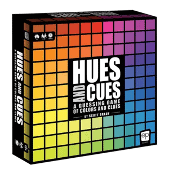
How do you describe a single shade of color in one hint? The board game Hues and Cues let’s you find out.
How well can you describe a color? Hues and Cues is a color themed guessing game that feels almost impossible to get right – which means everyone is on a level playing field. What color is “Apple”? Red, or green, or something else entirely? Prepare to find out the color association you have isn’t the same as everyone else’s…
Hues and Cues’ board looks a lot like the paper paint chip wall in a homeware store, showing a huge span of colors on a grid, that change by only a slight shade (or hue) between them. One player describes a color using first only one word, and the other players place a token on the color they think is being described. A second clue is given, with two words, and another round of guesses takes place, before the right answer is revealed. More points are gained by those in an area of the right answer.
A fun variation of this is to theme it to the 11 year old board gamers interests, simply by making the clues correspond to a theme. We’ve played many a successful Disney themed game (“Hercules” tends to draw up a terracotta kind of color in our experience, but “Fantasia” is a pretty particular blue) but have also known sports themes to go down well with older kids. It’s a popular game to get everyone thinking, chatting, theorizing, whilst expanding vocabulary and creativity too. Plus, it’s all played open, so if your younger player isn’t sure, they can try something similar to the majority, preventing them from feeling excluded by uncertainty.
We earn a commission if you make a
purchase, at no additional cost to you.
Pokémon Trading Card Game: Battle Academy
By: The Pokémon Company International
Players: 2
Time: 20-45 minutes

Often just referred to as the Pokemon Battle Academy, this game makes card battling easy
Pokémon Battle Academy is the board game version of the classic card game but taught in a way that makes it almost impossible not to get to grips with immediately. The wide reaching impact of Pokémon in adults and children alike make it a great game to be able to find other players for, as well as offering a chance at deck construction later down the line. Ultimately, the reason Pokémon has been so successful is that at its foundations, it’s really fun to play, and it’s remained prominent because of the huge community of players it maintains. Perfect then, for a 11 year old player establishing their own likes and dislikes, with the ability to share the experience with family and friends and adults alike too.
Pokémon Battle Academy is great for a number of reasons. Firstly, the price point is extremely competitive in comparison to other games like this, and it’s regularly on sale. It provides three decks, which means you can mix and match once you’ve got playing. And it also opens up the world of Pokémon, so if you want to play more, you only need to get more decks to do so… or if you really want to tumble down the rabbit hole, begin collecting!
Inside the box, you get a board that lays out exactly where your cards should be placed to prevent any confusion at all, and then each player gets a deck that’s in a specific order, and an instruction manual. The manual takes players through the game step by step, explaining the card that’s been drawn, what to do, and when to pass their turn to the other player, who then does the same with their own instruction book. Feeling almost like learning to ride a bike for the first time, after the instructions end, you’ll find you know exactly what you need to do to continue unsupported. Which is great, because there’s a third deck in the box for when you do!
We earn a commission if you make a
purchase, at no additional cost to you.
DroPolter
By: Oink Games
Players: 2-5
Time: 20 minutes
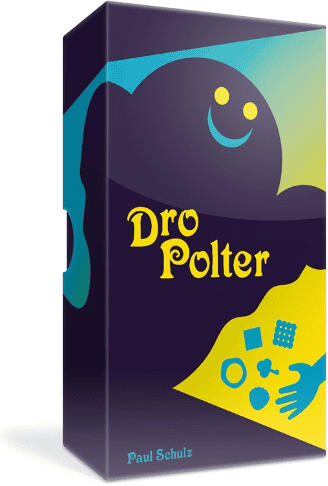
DroPolter isn’t your average board game, just as you’re not dealing with the average ghost!
A Japanese company called Oink Games make a whole range of fantastic and different games that fit into a hand sized box, and DroPolter is one of them. Overcoming any concerns that a big, intimidating board game box could bring with its tiny box, DroPolter is unassuming and inviting – but packs a big punch where play is concerned.
The idea of DroPolter is linked to a poltergeist, and dropping items from your hand. Opening the box you have a little treasure trove of items – plastic rings, ghost tokens, cubes, shells and more, plus a few cards. You have to keep the items given to you in your hand, but will then have to drop the items shown on the card turned over each round… ensuring you only drop the correct ones. If you win the round, you get to pick up a bell (a few of these marks victory), but the bell has to be stored in your hand, and they’re just as tricky to not drop!
Physically, DroPolter is a dexterity game (which for more, you should check out our list of the best dexterity games) that prioritizes hand movement, concentration, and hand eye coordination, all of which are useful in everyday life, but especially so at this age, as 11 year olds begin to experience different schoolwork, increased writing, and required precision. DroPolter isn’t the answer to struggles in these areas, but it certainly doesn’t hurt either. Add in a good laugh at every round, and a fun challenge to take part in, and DroPolter is a great one for 11 year olds to enjoy – and to tuck in their bag to play anywhere.
We earn a commission if you make a
purchase, at no additional cost to you.
Horrified: Universal Monsters
By: Ravensburger
Players: 1-5
Time: 60 minutes
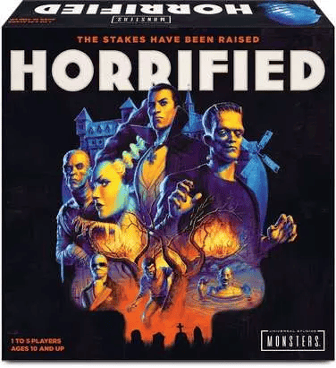
The Horrified Board Game raises the stakes!
Horrified shouldn’t be the word you think of when you’re thinking of board games, unless of course it’s Horrified: Universal Monsters! This Ravensburger game covered in classic monsters like Dracula and Frankenstein may not immediately shout “great game for a younger audience” at you, but if someone in the group likes Halloween, this is an absolutely perfect option.
The game sees the players working cooperatively to defeat the monsters wreaking havoc on the town. The way to do this is related to the monster themselves – you might be finding the cure for Wolf Man, or teaching Frankenstein and his Bride what it means to be human, or smashing the coffins of Dracula, etc. The game scales for ability, so you can pick the monsters to beat and the volume of monsters to suit the audience in front of you.
It’s a perfect game for 11 year olds who are looking to feel more grown-up to play with “scary monsters”, where the monsters are classic original monsters they’ll have likely grown up seeing cartoons of, and as such, are no longer actually scary. It’s got really simple game play, and it benefits from being a cooperative game – no chance for arguments across the table, it’s time to work together! There are always underlying benefits to playing board games, but this engaging game is also secretly teaching teamwork and strategy. Not bad for an afternoon replacing a movie with these monsters for a game with them instead!
We earn a commission if you make a
purchase, at no additional cost to you.
Quoridor
By: Gigamic
Players: 2-4
Time: 15 minutes
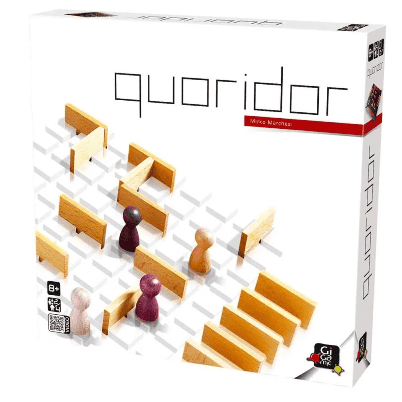
Quoridor might be the best alternative to Chess
Many parents aspire to get their child into chess at school, because it’s an abstract strategy game of skill instead of luck, with some studies suggesting that it can help improve reasoning skills and IQ. However, most aren’t successful as Chess can be slow and complex, and often that leaves a gap in games for a great strategy game at this age– which is where Quoridor is a great option. And despite being nearly twenty years old, it remains internationally popular. So, what is it?
Quoridor is simple to explain. Get your piece to the other side of the board. Each turn, you either move your piece a single square (forwards, backwards, or sideways), or you place a wall down somewhere. The goal is to get to the other side of the board, but your opponent will be doing the same, and potentially placing walls in your path, as you will in theirs. That’s essentially it – the entire game in less than a paragraph.
There are a few benefits to this, which include being able to easily teach (and so your 11 year old could equally easily teach others), but also being a two player game (though it goes up to four), guarantees some one-on-one time in an admittedly tense, but game related setting. They say it’s easier to talk about things that could be bothering you when you’re doing something else – well, why not a game of Quoridor?
The game is also made out of wooden components, which are robust and travel friendly, as well as feeling like a premium game as a result. You could leave a game of Quoridor set up on the table, and you’re bound to have visitors asking you about it. You’ll also overcome the barrier of needing to find and set up a game, if it’s simply awaiting you on the coffee table. Plus, a newly released variant includes Pac-Man pieces with a themed game mode that should be making its way to our shores soon!
We earn a commission if you make a
purchase, at no additional cost to you.
What Next?
By: Big Potato Games
Players: 1-4
Time: 30-60 minutes
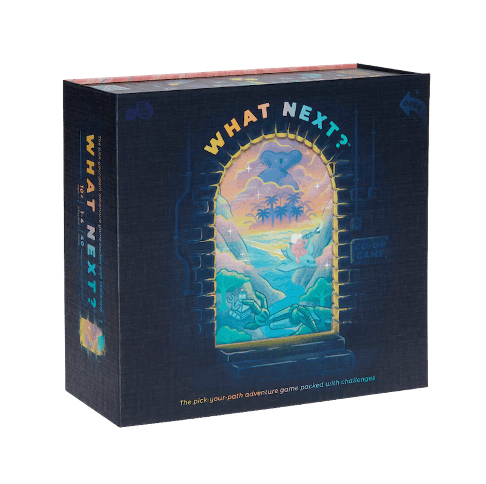
Adventure awaits you in What Next?
A game that mixes party game style challenges with a narrative choose-your-own-path style storyline, What Next? is perfect both for varied audiences, and for eleven year olds looking to feel more empowered in their decision making. So how does it actually work?
What Next? comes with three stories, each told in packs of cards. You read the story from the first card, and you might be asked to make a decision, like turning left or right, which will tell you which card from the deck to read next. When conflict arises though, like a locked door or an obstacle of any description, you’ll need to complete a challenge in order to clear it. That challenge could be something like flicking a puck on a board to make it land in a specific area, or finding a specific odd-shaped-piece from a bag of odd-shaped-pieces. Each of the challenges are ones that need equal part skill and luck, evening the ground between adult experience and younger lack of, but given its cooperative nature, everyone shares in successes. The game never asks for too much from you, but competing the challenges is a fun, off the table moment.
The game has beautiful illustrations, quirky stories that unfold as you make your way through the deck itself, and great opportunities to have a laugh within the challenges themselves. If you ever enjoyed choose your own adventure books but wanted to share a group experience with fun challenges, you can’t go wrong with What Next?.
We earn a commission if you make a
purchase, at no additional cost to you.
Mycelia
By: Ravensburger
Players: 1-4
Time: 45 minutes
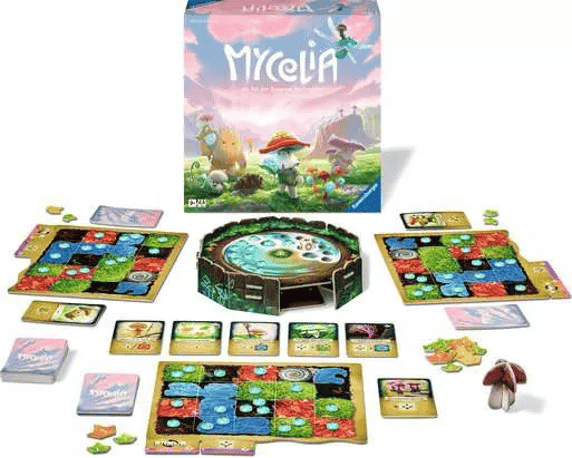
Mycelia is a gorgeous looking game, and a perfect one for 11 year olds!
Mycelia is a fun(gi) mushroom themed board game that wraps a great deck building experience in a series of gorgeous visuals. Whilst deck building can sound complicated, it’s essentially just picking cards that you’d like to play with, that you either earn or buy. Now there are some big, complicated games that use this mechanic, but Mycelia looks at all of them and refuses to be a part of it. Instead, it brings some really engaging, enchanting illustrations, makes mushrooms look cute, friendly and approachable, and encourages everyone to play a charming version of a competitive game.
In Mycelia, every card drawn in a hand that turn gets played, which means that there’s no difficulty in deciding what to do or what best move to make. In turn, this stops long, boring turns where a player can’t commit to the perfect move, making it a winner for the 11 year olds – though it’s suggested you can play this with as young as 9 year olds. Players will be attempting to remove the water drops from their personal board using the cards they have in their hand. They can buy more cards from the central pool, and these go into their deck to use next time it’s reshuffled. You win by clearing the water drops entirely. However, its additional areas make it particularly perfect for this age range.
The first, is that many cards played also have a benefit for the other players, such as each player might get extra purchasing tokens every time one player draws a specific card. Not all players lose well, and having an almost cooperative level within the game itself reduces potential for competitiveness to get out of hand. The second, is the mechanically unnecessary, but absolutely great fun Well that holds the drops you banish. Once you reach a certain point, you spin the Well and the drops cascade, sometimes triggering extra effects, but not necessarily. Having a tactile element, with a big dramatic drop, is appealing to all ages, but is perfect to capture the minds of the 11 year olds at the table! Once you finish, you’ll be reaching to play again, expanding the opportunity to strategize even further.
We earn a commission if you make a
purchase, at no additional cost to you.
Conclusion: Play a Board Game
You’re bound to find your 11 year olds next favorite game from our list, no matter the type of gamer they are. There’s nothing greater than getting the whole family together spending quality time, but with a few extra learning opportunities embedded within them, there’s no reason not to.
Don’t forget, we also have lists for other ages too, so if you’re preparing a game for other family members, there are plenty to choose from!
FAQ
What types of board games are best for 11 year olds?
Board games for 11 year olds should be engaging, easy to understand, and offer a mix of fun and educational value. Games such as What Next? and Mycelia are great choices as they combine narrative elements with cooperative or competitive gameplay, which helps in developing decision-making and social skills.
Are these games suitable for younger kids?
While the games listed are ideal for 11 year olds, many can also be enjoyed by younger children – and most family board games would be a good fit. For example, Mycelia can be played by kids as young as 9, making it versatile for family game night that include kids and adults alike, across a range of ages.
How do these games benefit children?
Board games like those mentioned aid in developing critical thinking, strategic planning, and social cooperation. Dexterity games like DroPolter help develop fine motor skills. They also provide an excellent opportunity for family bonding and can enhance a child and family’s cognitive skills through interactive and fun challenges.
Are these games available for purchase online?
Yes, most of these traditional board games can be found on various online platforms. For example, Mycelia is available through Ravensburger’s official website. Always ensure you are purchasing through a reputable source to guarantee the authenticity of the game.
Can these games be played solo or do they require multiple players?
Many of the games mentioned offer both solo and multiplayer modes. What Next? accommodates 1-4 players, making it flexible for both solo play and group activities. This versatility ensures that the games can be enjoyed by large groups regardless of the number of participants.
